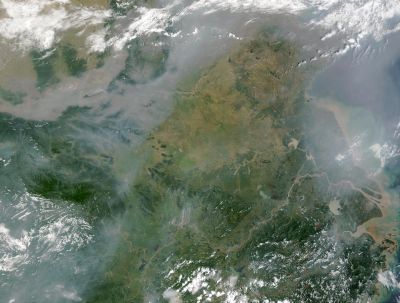Asian pollution worsens US air levels: study

Your support helps us to tell the story
From reproductive rights to climate change to Big Tech, The Independent is on the ground when the story is developing. Whether it's investigating the financials of Elon Musk's pro-Trump PAC or producing our latest documentary, 'The A Word', which shines a light on the American women fighting for reproductive rights, we know how important it is to parse out the facts from the messaging.
At such a critical moment in US history, we need reporters on the ground. Your donation allows us to keep sending journalists to speak to both sides of the story.
The Independent is trusted by Americans across the entire political spectrum. And unlike many other quality news outlets, we choose not to lock Americans out of our reporting and analysis with paywalls. We believe quality journalism should be available to everyone, paid for by those who can afford it.
Your support makes all the difference.Pollution from Asia is boosting levels of ozone in the skies above the western United States, a trend that could hamper US efforts to meet tougher smog standards, experts said on Wednesday.
Their study focusses on data for ozone in springtime above western North America at an altitude of between three and eight kilometers (two and five miles).
This height is between the stratosphere - where a thin layer of ozone helps to filter out dangerous ultra-violet light from the Sun - and ground level, where ozone can be a bad hazard for people with cardiac or respiratory problems.
The paper, published in the British journal Nature, said that ozone levels in the monitored area rose by 14 percent in springtime from 1995 and 2008.
When data were included for 1984, the year with the lowest average ozone level, the increase from that date up to 2008 was a whopping 29 percent.
The surge could only be explained by pollutants that are the precursors to ozone and were borne across the Pacific from East and South Asia by powerful winds, it says.
The chief man-made sources of ozone are nitrogen oxides and volatile organic compounds, which are gases that are the byproduct of burning fossil fuels. They react with sunlight to produce ozone, a triple molecule of oxygen.
During the time monitored in the study, US domestic emissions of these precursor gases declined.
"In springtime, pollution from across the hemisphere, not nearby sources, contributes to the ozone increases above western North America," lead author Owen Cooper of the Cooperative Institute for Research in Environmental Sciences at the University of Colorado said.
"When air is transported from a broad region of South and East Asia, the trend is largest," he said in a press release.
The findings are important, as previous research suggests pollution at the altitude monitored in the study can descend and mix with surface air.
If so, a long-standing question may be answered. There has been a rise in ozone levels in parts of the rural western United States, but there is little road traffic or industry in these regions to explain the increase.
The paper says the phenomenon could have repercussions for efforts in the United States to roll back its smog problem with tougher car-exhaust measures and other initiatives.
"The observed increase in springtime background ozone mixing ratio may hinder the USA's compliance with its ozone air quality standard," it says.
Join our commenting forum
Join thought-provoking conversations, follow other Independent readers and see their replies
Comments